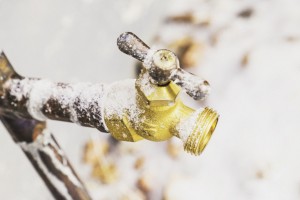 Research from Farmers Insurance shows that 63 percent of claims related to frozen pipes occur between December and February. The best way to handle frozen pipes is to prevent them before winter hits, so now is the time to winterize your home to ensure your plumbing is prepared for cold temperatures.
Research from Farmers Insurance shows that 63 percent of claims related to frozen pipes occur between December and February. The best way to handle frozen pipes is to prevent them before winter hits, so now is the time to winterize your home to ensure your plumbing is prepared for cold temperatures.
Prevent Frozen Pipes
Avoid the cleanup and plumbing repairs caused by a burst pipe by using these tips:
- HVAC unit maintenance: If the HVAC unit is connected to your pipes and the unit fails, cold temperatures can quickly affect your plumbing.
- Inspect home: Look for cracks around the foundation and basement area of your home. Use caulk and spray foam to fill cracks to prevent cold air from reaching your pipes.
- Insulate pipes: Pipe insulation alone is not enough to protect your pipes. Run heat cables along the pipes then wrap the insulation around the cable.
- Open cabinets: The warm air that runs through your home won’t reach the pipes under cabinets. Open the cabinet doors to allow the warmth to circulate the pipes.
- Run water: A slow drip through the faucet will keep water moving and prevent frozen pipes.
- Turn off outdoor valves: Allow the bleed cap to drain, which removes all excess water from your outdoor faucets. Shut off the water valve once that’s complete to avoid frozen pipes.
Thaw Frozen Pipes
Look for these warning signs if you fear your pipes are frozen:
- Sewage smell: When water freezes in your pipes, sewage gases escape through your drains.
- Frost: Visible pipes in crawl spaces and beneath your cabinets may show frost if they are frozen.
- No water: If your water supply stops or only drips emerge from the faucet, the water pipe connected to the fixture may be frozen.
If you discover your pipes are frozen, use these ways to thaw pipes.
- Turn up the heat. If the frozen pipe is behind a wall and has not bursts, crank up your heat.
- Use an infrared lamp. An infrared lamp can direct heat through the wall to heat the pipe.
- Use a hair dryer. If the frozen pipe is exposed, use a hair dryer to warm the pipe’s surface.
- Trap heat with a cookie sheet. Use a heat lamp for exposed pipes and position a baking sheet behind the pipe to help hold in warmth and thaw the pipe more quickly.
- Position a portable heater nearby. A small heater near the pipes will help warm a confined space and release the frozen water.
- Wrap pipe with electric heat tape. Heat tape contains an electrical heating element. Wrap the tape around the pipe and plug it into the wall. Most have a thermostat to control the temperature.
If these methods don’t remedy your frozen pipe or the pipe bursts, call a professional plumber to prevent any further damage to your plumbing system.
